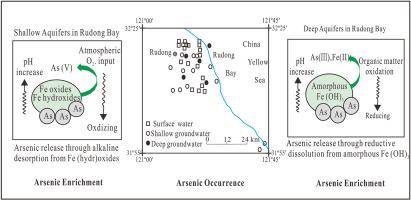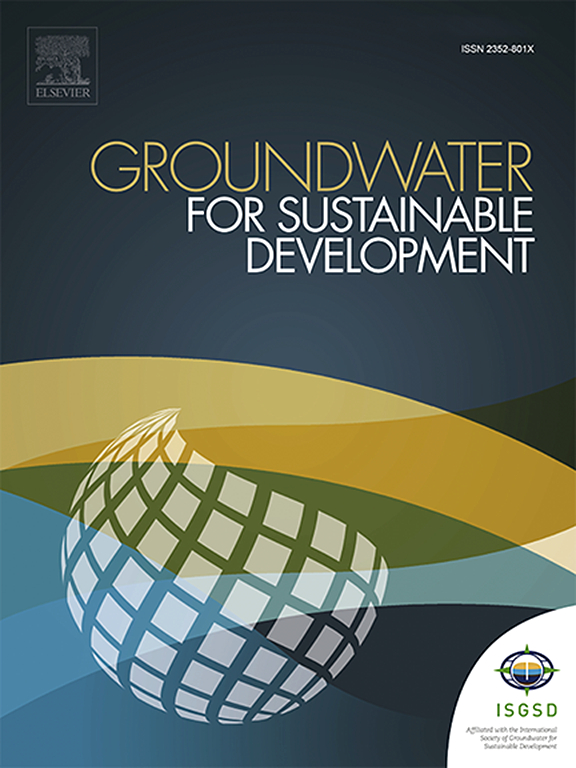中国东部沿海富砷地下水的出现与富集机制
IF 4.9
Q2 ENGINEERING, ENVIRONMENTAL
引用次数: 0
摘要
在沿海含水层中,地下水砷(As)污染是一个值得注意的现象。本研究采用化学分析和地球化学模拟的方法,研究了华东地区沿海含水层中富砷地下水的发生和富集机理。最近的水文地质调查表明,砷污染样品主要集中在如东湾,砷污染同时发生在还原性和氧化性沿海含水层中。根据 Piper 图、Gibbs 图和岩石风化图,浅层地下水和深层地下水分别为 Na-HCO3 层和 Na-Ca-Mg-HCO3 混合层,受污染地下水的水化学性质受风化和溶解作用的影响。此外,浅层地下水的高盐度可能与海水入侵有关。根据 PHREEQC 模型预测,浅层地下水中 As (V) (HAsO42-) 是主要的 As 分 子,而深层地下水中的 As (Ⅲ) (H3AsO3) 则与之相对应。化学物质统计分析和模型计算表明,碱性解吸是浅层地下水中砷富集的原因,而还原溶解是深层地下水中砷富集的主要过程。氧化还原和 pH 值振动在造成沿海平原浅层和深层含水层砷富集机制差异方面发挥了重要作用。该研究结果可加深对沿海地区含水层中富砷地下水的发生和富集机理的认识。本文章由计算机程序翻译,如有差异,请以英文原文为准。

Occurrence and enrichment mechanism of arsenic-rich groundwater from eastern coastal China
Groundwater arsenic (As) contamination represents a noteworthy occurrence within coastal aquifers. This work employs an approach of chemical analysis and geochemical modelling to study the occurrence and enrichment mechanism of As-rich groundwater within coastal aquifers in East China. Recent hydrogeological survey demonstrates that the As contaminated samples are clustered in Rudong Bay and As contamination occurs within both reducing and oxidizing coastal aquifers. The Piper, Gibbs, and Rock-Weathering diagrams signify shallow and deep groundwater are Na–HCO3 and mixed Na·Ca·Mg–HCO3 facies respectively, and the hydrochemistry of contaminated groundwater is governed by weathering and dissolution. Moreover, high salinity in shallow groundwater can be associated with seawater intrusion. The PHREEQC modeling predicts that As (V) (HAsO42−) is the dominant As speciation in shallow groundwater, while As (Ⅲ) (H3AsO3) is the counterpart in deep groundwater. Statistical analysis of chemicals and modeling calculations suggest that alkaline desorption is responsible for As enrichment in shallow groundwater, while reductive dissolution is the primary processes governing As enrichment in deep groundwater. Redox and pH vibrations play an important role in generating the differences of As enrichment mechanism between shallow and deep aquifers in the coastal plain. The findings of this study may enhance understanding the occurrence and enrichment mechanism about As-rich groundwater within coastal area aquifers.
求助全文
通过发布文献求助,成功后即可免费获取论文全文。
去求助
来源期刊

Groundwater for Sustainable Development
Social Sciences-Geography, Planning and Development
CiteScore
11.50
自引率
10.20%
发文量
152
期刊介绍:
Groundwater for Sustainable Development is directed to different stakeholders and professionals, including government and non-governmental organizations, international funding agencies, universities, public water institutions, public health and other public/private sector professionals, and other relevant institutions. It is aimed at professionals, academics and students in the fields of disciplines such as: groundwater and its connection to surface hydrology and environment, soil sciences, engineering, ecology, microbiology, atmospheric sciences, analytical chemistry, hydro-engineering, water technology, environmental ethics, economics, public health, policy, as well as social sciences, legal disciplines, or any other area connected with water issues. The objectives of this journal are to facilitate: • The improvement of effective and sustainable management of water resources across the globe. • The improvement of human access to groundwater resources in adequate quantity and good quality. • The meeting of the increasing demand for drinking and irrigation water needed for food security to contribute to a social and economically sound human development. • The creation of a global inter- and multidisciplinary platform and forum to improve our understanding of groundwater resources and to advocate their effective and sustainable management and protection against contamination. • Interdisciplinary information exchange and to stimulate scientific research in the fields of groundwater related sciences and social and health sciences required to achieve the United Nations Millennium Development Goals for sustainable development.
 求助内容:
求助内容: 应助结果提醒方式:
应助结果提醒方式:


